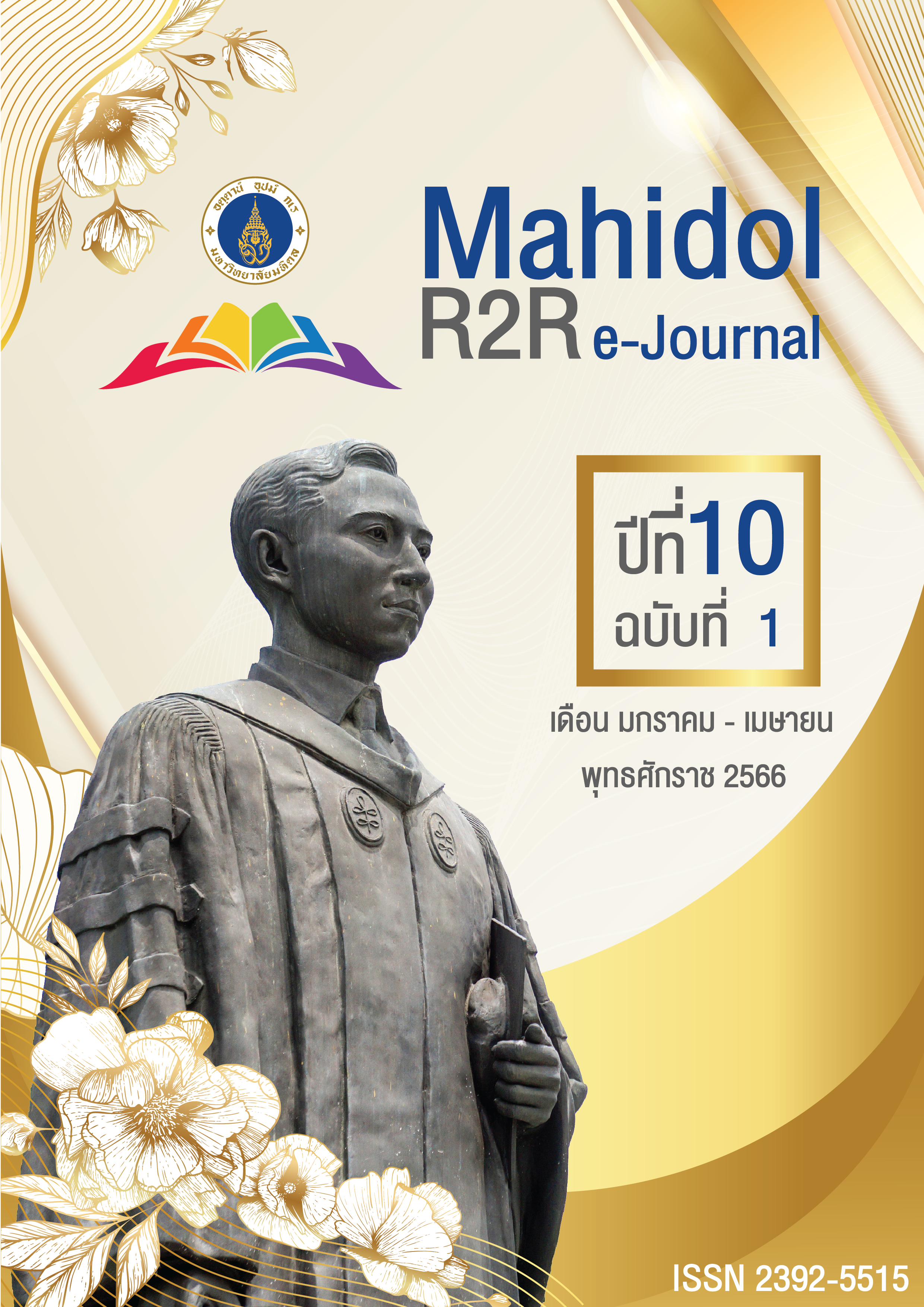ประสิทธิภาพของน้ำยา 0.12% คลอเฮกซิดีนกลูโคเนต ด้านการฆ่าเชื้อแบบครั้งคราว ในระบบท่อส่งน้ำของยูนิตทำฟัน
DOI:
https://doi.org/10.14456/jmu.2023.3คำสำคัญ:
ระบบท่อส่งน้ำของยูนิตทำฟัน, จุลินทรีย์, คลอเฮกซิดีนกลูโคเนตบทคัดย่อ
น้ำที่ไหลเข้าระบบท่อส่งน้ำของยูนิตทำฟัน (dental unit waterline: DUWL) มีปริมาณจุลินทรีย์จำนวนเล็กน้อย ขณะที่เมื่อฉีดพ่นเข้าสู่ช่องปากกลับมีปริมาณเพิ่มมากขึ้น ซึ่งอาจจะทำให้ทั้งผู้ป่วยและบุคลากรทางทันตกรรมมีความเสี่ยงต่อการติดเชื้อบางอย่างได้ วัตถุประสงค์: เพื่อศึกษาประสิทธิภาพและหาความถี่ที่เหมาะสมของการใช้น้ำยา 0.12% คลอเฮกซิดีนกลูโคเนต (chlorhexidine gluconate: CHX) แบบครั้งคราว สำหรับฆ่าเชื้อภายในระบบท่อส่งน้ำของยูนิตทำฟัน วัสดุอุปกรณ์และวิธีการ: สามยูนิตทำฟันถูกกำหนดเป็นยูนิต A, B และ C ตามลำดับ ซึ่งมีภาชนะเก็บน้ำของตัวเองถูกใช้ในการศึกษาเป็นเวลาสองสัปดาห์ ในแต่ละสัปดาห์ได้ทำการฆ่าเชื้อ DUWL ของยูนิต A เป็นเวลา 5 วัน (วิธีที่ 1) และยูนิต B เป็นเวลา 1 วัน (วิธีที่ 2) ตลอดทั้งคืนด้วย 0.12% CHX ส่วนยูนิต C ไม่ได้ทำการฆ่าเชื้อเพื่อใช้เป็นยูนิตควบคุม ตัวอย่างน้ำถูกเก็บภายใน 2 สัปดาห์ น้ำกรองของโรงพยาบาลศิริราชซึ่งเป็นแหล่งน้ำของยูนิตทำฟันถูกเก็บ 1 ตัวอย่างต่อสัปดาห์ และก่อนการฆ่าเชื้อ DUWL ตัวอย่างน้ำ 3 ตัวอย่างจากแต่ละยูนิตทำฟัน (A, B, C) ถูกเก็บเพื่อใช้เป็นตัวอย่างพื้นฐาน หลังการฆ่าเชื้อ DUWL น้ำจากแต่ละยูนิต A และ B ถูกเก็บ 1 ตัวอย่างต่อวัน 5 วันต่อสัปดาห์เพื่อใช้เป็นตัวอย่างทดสอบ สำหรับยูนิต C น้ำถูกเก็บ 1 ตัวอย่างต่อวัน 5 วันต่อสัปดาห์เพื่อใช้เป็นตัวอย่างควบคุม ตัวอย่างน้ำทั้งหมดจำนวน 35 ตัวอย่าง ถูกส่งตรวจเพื่อหาปริมาณจุลินทรีย์แอโรบิกทั้งหมด (total aerobic microbial count) และชนิดของจุลินทรีย์ตามมาตรฐานน้ำดื่ม
ผล: เมื่อเปรียบเทียบกับมาตรฐานที่กำหนดโดยสมาคมทันตแพทย์แห่งสหรัฐอเมริกา (200 cfu/ml) พบว่าตัวอย่างน้ำจากยูนิตทำฟันทั้งหมดในแต่ละสัปดาห์มีปริมาณจุลินทรีย์มากกว่ามาตรฐาน และเมื่อเปรียบเทียบกับตัวอย่างควบคุม พบว่าปริมาณจุลินทรีย์ที่ต่ำกว่าอย่างมีนัยสำคัญพบได้จากยูนิต A ในสัปดาห์ที่ 1 หลังการฆ่าเชื้อ (P = 0.034) เท่านั้น และมีความแตกต่างอย่างไม่มีนัยสำคัญของปริมาณจุลินทรีย์ในตัวอย่างอื่นๆ ในช่วงเวลาที่ทำการทดลอง
บทสรุป: ภายใต้ข้อจำกัดของการศึกษาคุณสมบัติทางชีววิทยาในหลอดทดลอง (in vitro study) นี้ พบว่าการใช้น้ำยา 0.12% CHX ในการฆ่าเชื้อ DUWL แบบครั้งคราวไม่สามารถลดการปนเปื้อนของจุลินทรีย์ให้ได้ตามมาตรฐานสากล ดังนั้นจึงแนะนำว่าถ้าเป็นไปได้ควรใช้น้ำยา 0.12% CHX ฆ่าเชื้อด้วยความถี่ที่มากกว่าห้าวันต่อสัปดาห์เพื่อให้ได้ประสิทธิภาพสูงสุดในการฆ่าเชื้อ DUWL
เอกสารอ้างอิง
ADA Council on Scientific Affairs [CSA]. (1999). Dental unit waterlines: approaching the year 2000. Journal of the American Dental Association, 130(11), 1653–1664.
Ajami, B., Ghazvini, K., Movahhed, T., Ariaee, N., Shakeri, MT., & Makarem, S. (2012). Contamination of a dental unit water line system by legionella pneumophila in the Mashhad School of Dentistry in 2009. Iranian Red Crescent Medical Journal, 14(6), 376–378.
Atlas, RM., Williams, JF., & Huntington, MK. (1995). Legionella contamination of dental-unit waters. Applied and Environmental Microbiology, 61(4), 208–1213. https://doi.org/10.1128/aem.61.4.1208-1213.1995
Blake, GC. (1963). The incidence and control of bacterial infection of dental spray reservoirs. British Dental Journal, 115(10), 413–416.
Donlan, RM. (2002). Biofilms: microbial life on surfaces. Emerging Infectious Diseases, 8(9), 881–890.https://doi.org/10.3201/eid0809.020063
Donlan, RM., & Costerton, JW. (2002). Biofilms: survival mechanisms of clinically relevant microorganisms.Clinical Microbiology Reviews, 15(2), 167–193.https://doi.org/10.1128/CMR.15.2.167-193.2002
Harper, NJN., Cook, TM., Garcez, T., Farmer, L., Floss, K., Marinho, S., Torevell, H., Warner, A., Ferguson, K., Hitchman, J., Egner, W., Kemp, H., Thomas, M., Lucas, DN., Nasser, S., Karanam, S., Kong, KL., Farooque, S., Bellamy, M., & McGuire, N. (2018). Anaesthesia, surgery, and life-threatening allergic reactions: epidemiology and clinical features of perioperative anaphylaxis in the 6th National Audit Project (NAP6).British Journal of Anaesthesia, 121(1), 159–171.https://doi.org/10.1016/j.bja.2018.04.014
Karpay, RI., Plamondon, TJ., Mills, SE., & Dove, SB.(1999).Combining periodic and continuous sodium hypochlorite treatment to control biofilms in dental unit water systems. Journal of the American Dental Association, 130(7), 957–965. https://doi.org/10.14219/jada.archive.1999.0336
Martin, MV. (1987). The significance of the bacterial contamination of dental unit water systems. British Dental Journal, 163(5), 152–154. https://doi.org/10.1038/sj.bdj.4806220
Mills, SE.(2000).The dental unit waterline controversy: defusing the myths, defining the solutions. Journal of the American Dental Association, 131(10), 1427–1441.https://doi.org/10.14219/jada.archive.2000.0054
Morrison, AJ. Jr., & Shulman, JA.(1986). Community-acquired bloodstream infection caused by Pseudomonas paucimobilis: case report and review of the literature. Journal of Clinical Microbiology, 24(5), 853–855. https://doi.org/10.1128/jcm.24.5.853-855.1986
Noopan, S., Unchui, P., Techotinnakorn, S., & Ampornaramveth, RS.(2019).Plasma sterilization effectively reduces bacterial contamination in dental unit waterlines. International Journal of Dentistry, 2019(4), 1–6. https://doi.org/10.1155/2019/5720204
Pankhurst, CL. (2003). Risk assessment of dental unit waterline contamination. Primary Dental Care, 10(1), 5–10. https://doi.org/10.1308/135576103322504030
Porteous, NB. & Cooley, RL. (2004). Reduction of bacterial levels in dental unit waterlines. Quintessence International, 35(8), 630–634.
Schiff, J., Suter, LS., Gourley, RD., & Sutliff, WD. (1961). Flavobacterium infection as a cause of bacterial endocarditis. Report of a case, bacteriologic studies, and review of the literature. Annals of Internal Medicine, 55(3), 499–506. https://doi.org/10.7326/0003-4819-55-3-499
Singh, V., Nagaraja, C., & Hungund, SA. (2013). A study of different modes of disinfection and their effect on bacterial load in dental unit waterlines.European Journal of General Dentistry, 2(3), 246–251. https://doi.org/10.4103/2278-9626.115999
Szymańska, J., Sitkowaska, J., & Dutkiewicz, J. (2008). Microbial contamination of dental unit waterlines.Annals of Agricultural and Environmental Medicine, 15(2), 173–179.
Walker, JT., Bradshaw, DJ., Finney, M., Fulford, MR., Frandsen, E., ØStergaard, E., ten Cate, JM., Moorer, WR., Schel, AJ., Mavridou, A., Kamma, JJ., Mandilara, G., Stösser, L., Kneist, S., Araujo, R., Contreras, N., Goroncy-Bermes, P., O’Mullane, D., Burke, F., . . . Marsh, PD. (2004). Microbiological evaluation of dental unit water systems in general dental practice in Europe. European Journal of Oral Sciences, 112(5), 412–418. https://doi.org/10.1111/j.1600-0722.2004.00151.x
Zhang, W., Onyango, O., Lin, Z., Lee, SS., & Li, Y. (2007). Evaluation of Sterilox for controlling microbial biofilm contamination of dental water.Compendium of Continuing Education in Dentistry, 28(11), 586–588, 590–592.
ดาวน์โหลด
เผยแพร่แล้ว
ฉบับ
ประเภทบทความ
สัญญาอนุญาต
ลิขสิทธิ์ (c) 2023 Mahidol R2R e-Journal

อนุญาตภายใต้เงื่อนไข Creative Commons Attribution-NonCommercial-NoDerivatives 4.0 International License.




